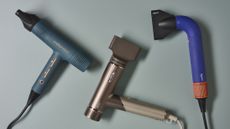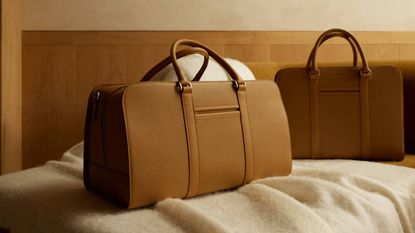Style
The latest Style breaking news, comment, reviews and features from the experts at T3
-

Best hair dryer 2025: quick and frizz-free drying for all hair types
Find our top picks from Dyson, Shark, ghd and more
By Lizzie Wilmot Last updated
-

Best women's perfumes and fragrances 2025: hit the right notes
Find the best women's perfumes, from sweet and decadent to exotic and green
By Bethan Morgan Last updated
-

Best LED face mask 2025: luxury beauty tech for brighter, healthier skin
Tackle all your skincare concerns
By Lizzie Wilmot Last updated
-

Oral-B's best electric toothbrush is 70% off this Amazon Prime Day – yes really!
The Oral-B iO5 electric toothbrush has a massive discount for Prime Day – don't miss out on the deal of 2025
By Max Slater-Robins Published
-

Dyson drops huge Prime Day discount on the Airwrap i.d. – don't miss out on early Christmas presents
Dyson's Airwrap i.d. is one of the most sought after hair gadgets in 2025
By Max Slater-Robins Published
-

I’m a men’s fragrances expert – 7 Prime Day deals you should buy from Tom Ford, Hugo Boss and more
Get up to 61% off men’s fragrances during Prime Big Deal Days
By Bethan Morgan Published
-

I tested Marc Jacobs Perfect Absolute – sweet and sultry, but is it for the right season?
How does Perfect Absolute compare to Marc Jacobs’ Perfume line-up?
By Bethan Morgan Published
-

Shark’s limited edition hair styler drops to under £200 for Pay Day
Up your hair game with this Shark FlexStyle deal
By Bethan Morgan Published
-

Retro tennis meets streetwear cool in this sharp sneaker from a low-key Portuguese brand
JAK’s handmade Vantage trainers land in crisp new colourways, serving retro vibes with contemporary edge
By Matt Kollat Published
-

Go back to school in style with this Berghaus unisex backpack – 33% off with Amazon Prime Day deals
Berghaus makes some of the best backpacks on the market, ideal for students of all ages
By Max Slater-Robins Published
-

7 Hugo Boss fragrances that are better than half price in the Prime Day sale
T3’s favourite BOSS fragrances for men are the cheapest they’ve ever been
By Bethan Girdler-Maslen Published
-

The 5 best hair curlers available now – according to T3's team of beauty tech experts
Find the best hair curlers that give you beautiful bouncy curls that stay all day
By Lizzie Wilmot Last updated
-

Best backpack 2025: bag options for work, commuting and travelling
Find the best backpacks and rucksacks to keep your laptop, tablet and other tech safe and stylish
By Lizzie Wilmot Last updated
-

T3 Awards 2025: all Home and Style winners announced!
From vacuums and purifiers to LED face masks and fragrance, here are T3’s Home and Style award winners
By Bethan Girdler-Maslen Published
-

Ghd’s new Wave hair curler is giving me major 90s nostalgia
Ghd brings back the barrel curler with its new Wave hair tool
By Bethan Girdler-Maslen Published
-

10 most popular Father’s Day fragrances to give dad this year, according to experts
The Perfume Shop reveals 10 predicted bestselling scents for Father’s Day
By Bethan Girdler-Maslen Published
-

Forget Specsavers – I used a luxury online optician and I'm never going back to the high street
Fashion Eyewear offers a compelling array of luxury specs
By Sam Cross Published
-

The Argos Big Red Event is back – 9 home and garden deals you should buy
Get up to 50% off air fryers, video doorbells and blenders in Argos’ Big Red Event
By Bethan Girdler-Maslen Published
-

Stubble & Co Classic Backpack 15L review: simple, effective elegance
A great backpack (if you don't have pets)
By Max Freeman-Mills Published
-

Amorecco debuts ‘world’s first lickable’ perfume – yes, really!
This gelato-inspired perfume can be eaten for a multi-sensory experience
By Bethan Girdler-Maslen Published
-

Harber London’s new laptop sleeve is smart, sleek and effortlessly luxurious
There are two in the collection
By Lizzie Wilmot Published
-

I tried the Gtech DryOnic Hair Dryer and it could give Dyson a run for its money – here’s why
Gtech takes on Dyson and Shark with its own hair dryer, but how does it measure up?
By Bethan Girdler-Maslen Published
-

TAG Heuer’s new sunglasses are ultra-light and vintage-inspired – but they’ll cost you
TAG Heuer is back with new vintage-inspired eyewear line-up
By Bethan Girdler-Maslen Published
-

This curler is the strangest hair tool I’ve ever seen, and it solves one key styling problem
mdlondon’s Curl proves that hair curlers are making a comeback
By Bethan Girdler-Maslen Published
-

My top 5 favourite Tom Ford fragrances drop to super low price in Amazon’s spring sale
Tom Ford fragrances are my favourite – and they’re up to 45% off right now
By Bethan Girdler-Maslen Published
-

Troubador's new Matrix backpack will keep your tech safe and sound
It quite literally has your back
By Lizzie Wilmot Published
-

I tried the Wahl Vanquish Hair Dryer and it's as powerful as it is portable
The Wahl Vanquish is a compact and lightweight yet powerful hairdryer
By Alistair Charlton Published
-

I tried Dua Lipa’s favourite perfume and it quickly became mine too – here’s why
Yves Saint Laurent Libre is my favourite date night fragrance
By Bethan Girdler-Maslen Published
-

Dyson finally launches its Supersonic r hair dryer to the public – as weird and wonderful as before
Dyson’s hair stylist-approved hair dryer is finally available in the UK
By Bethan Girdler-Maslen Published
